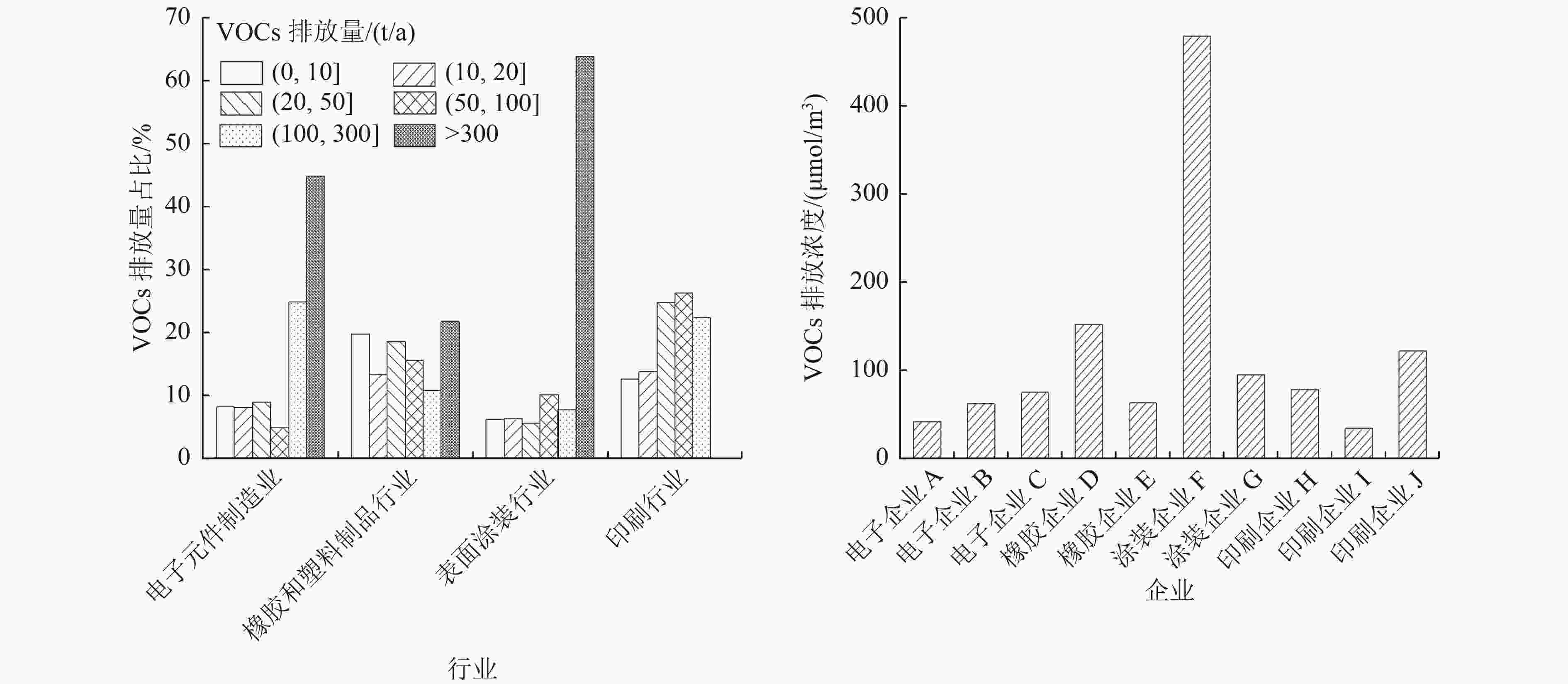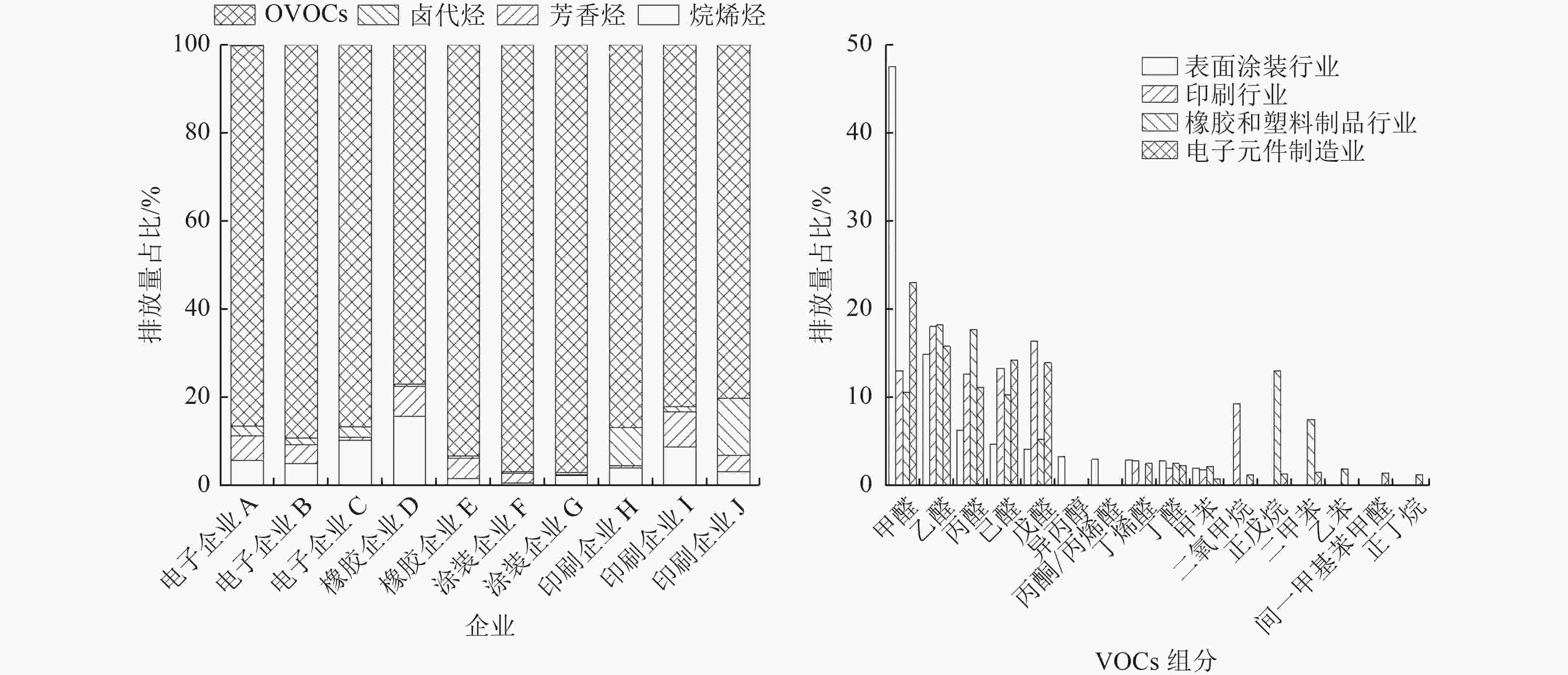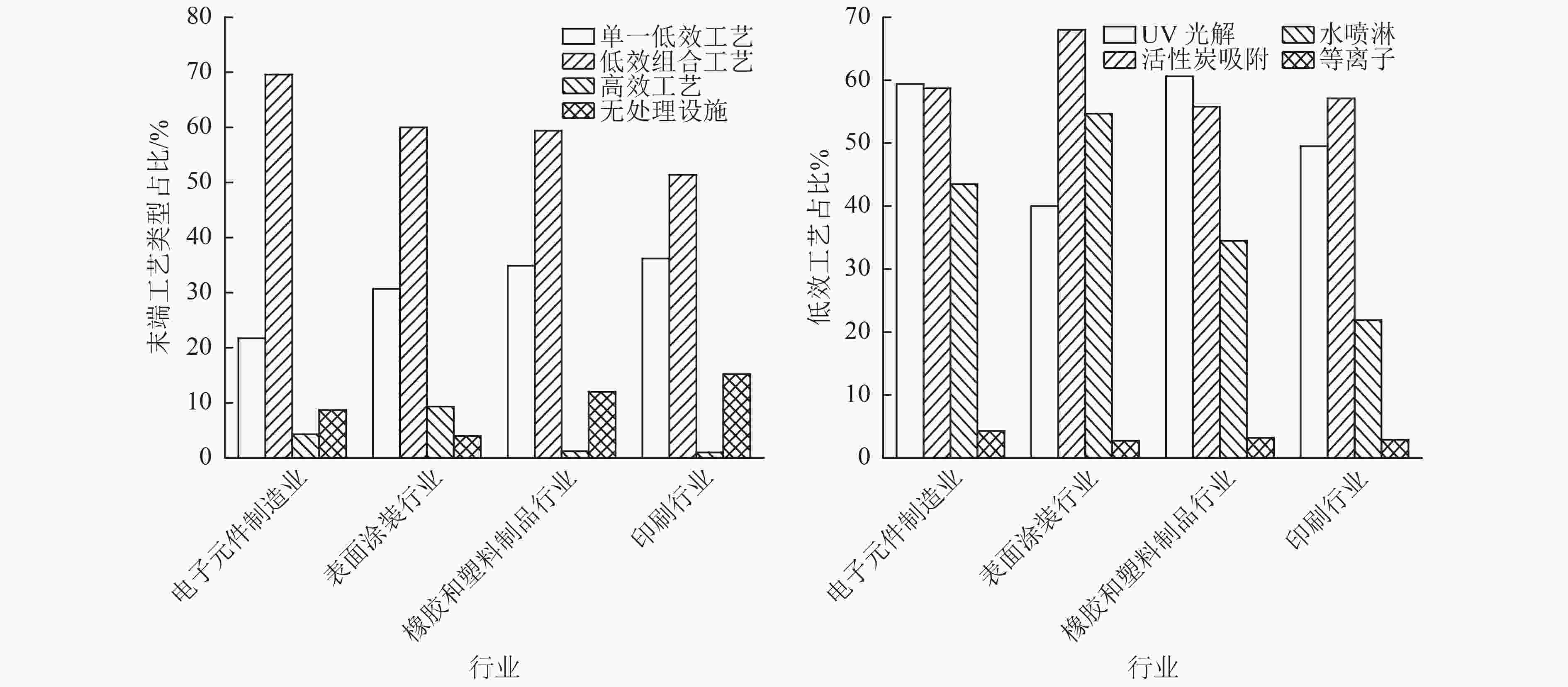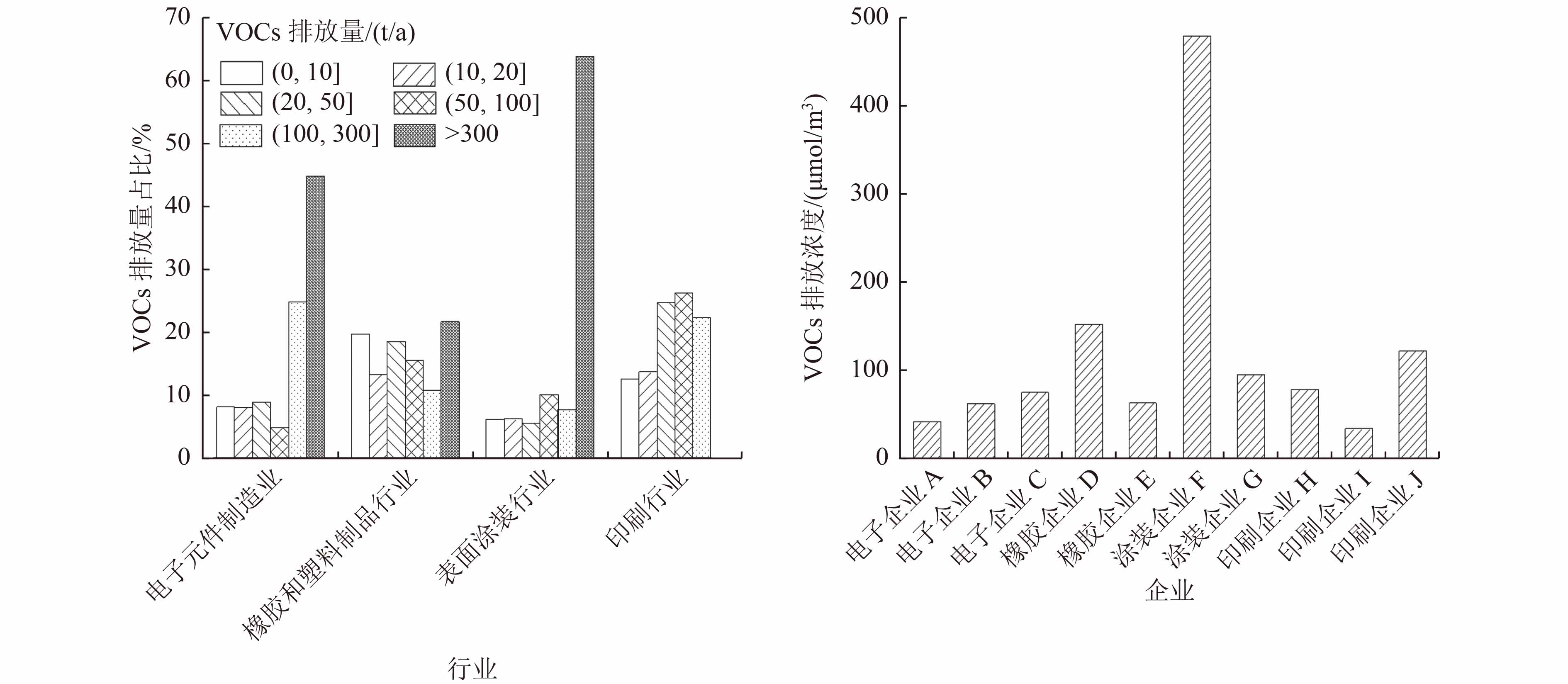Emission characteristics, treatment status and mitigation countermeasures of volatile organic compounds from typical solvent sources in Shenzhen City
-
摘要:
为强化工业企业VOCs的综合整治,选取工业经济发达的深圳市作为研究区域,通过实地调研和现场检测的方式探讨了橡胶和塑料制品行业、印刷行业、表面涂装行业、电子元件制造业等典型溶剂使用源的VOCs排放特征和末端治理现状,并就源头替代和末端管理提出了具体的减排对策。结果表明:深圳市典型溶剂使用源VOCs的平均排放量为表面涂装(51.8 t/a)>电子元件(36.5 t/a)>印刷(21.0 t/a)>橡胶塑料(17.4 t/a),不同排放规模的橡胶塑料企业和印刷企业对各自行业的排放贡献较为均匀,而排放量>300 t/a的涂装企业、电子企业对各自行业的贡献率则分别占63.9%、44.9%;受水性原料替代和末端治理设施等控制政策的影响,四大行业固定排放源VOCs组分以OVOCs为主(排放量占比为76.8%~97.0%),特征污染物为甲醛和乙醛;四大行业末端工艺类型均以UV光解、水喷淋、活性炭吸附的低效组合工艺为主,占比约51.4%~69.6%;评估结果显示,所测试的典型组合工艺中,78%的设施平均处理率均低于35%,治理方案缺乏针对性、运行管理缺乏规范性是造成溶剂使用源VOCs末端削减率偏低的主要因素。因此,为控制未来溶剂使用源VOCs排放量,应当推动源头排放控制从“底线约束”向“先进带动”持续转变;末端治理应统筹考虑技术可行性和管理有效性,确保实现行业VOCs排放总量的高效削减。
Abstract:In order to strengthen the comprehensive regulation of industrial volatile organic compounds (VOCs), Shenzhen City, a developed industrial and economic area, was selected as the research area. Through field investigation and field testing, the VOCs emission characteristics and end-of-pipe (EOP) treatment status of typical solvent sources such as rubber and plastic products industry, printing industry, surface coating industry and electronic components manufacturing industry were discussed. At the same time, some specific measures of emission reduction for source substitution and terminal management were made. The results showed that: The average emission of VOCs from typical solvent sources in Shenzhen City was in the order of surface coating (51.8 t/a) > electronic components (36.5 t/a) > printing (21.0 t/a) > rubber and plastic (17.4 t/a). Rubber enterprises and printing enterprises of different emission scales contributed more evenly to their respective industries, while painting enterprises and electronic enterprises with emissions higher than 300 t/a contributed 63.9% and 44.9% to their respective industries, respectively. Under the influence of control policies such as the substitution of water-based raw materials and the promotion of EOP treatment facilities, OVOCs were the main VOCs components of the four industries' fixed emission sources, with a mass proportion ranging from 76.8% to 97.0%. Besides, the characteristic pollutants were formaldehyde and acetaldehyde. The EOP process types of the four industries were mainly the inefficient combination of UV photolysis, water spraying and activated carbon adsorption, accounting for about 51.4%-69.6%. The evaluation results showed that 78% of the tested typical combined processes had an average treatment efficiency of lower than 35%. The lack of pertinence of treatment schemes and the lack of standardization of operation management were the main factors causing the low EOP reduction rate of VOCs from the sources of solvent use. Therefore, in order to control the emission of VOCs from the sources of solvent use in the future, the source control should be promoted from "baseline constraint" to "advanced driven". The EOP treatment should comprehensively consider the technical feasibility and management effectiveness to ensure the efficient reduction of the total amount of VOCs emissions in the industries.
-
表 1 固定排放源排放组分的样品信息
Table 1. Sample information on the emission components from stationary emitters
样品编号 主要原辅料 VOCs来源 末端工艺 电子企业A 溶剂油墨 丝印 水喷淋+UV光解 电子企业B 乙酸乙酯 涂布 UV光解 电子企业C 聚碳酸酯(PC)丙烯腈-丁二烯-苯乙烯共聚物(ABS) 注塑 等离子+UV光解+水喷淋+
活性炭吸附橡胶企业D ABS、聚丙烯(PP)、聚氯乙烯(PVC) 注塑 水喷淋+UV光解+活性炭吸附 橡胶企业E 油性漆 喷涂 水喷淋+UV光解+活性炭吸附 涂装企业F 水性漆、
油性漆喷涂 蓄热式热氧化技术
(regenerative thermal oxidizer,RTO)涂装企业G 聚酯粉末 喷涂 催化燃烧
(catalytic oxidizer,CO)印刷企业H 大豆油墨、水性油墨 印刷 UV光解+活性炭吸附 印刷企业I UV油墨 印刷 UV光解 印刷企业J UV油墨 印刷 水喷淋+活性炭吸附 表 2 深圳市典型溶剂使用源末端工艺的处理率
Table 2. Efficiency of EOP processes of typical solvent sources in Shenzhen City
行业 VOCs来源 末端设施编号 处理工艺 处理率/% 平均处理率/% VOCs排放量/(t/a) 橡胶和塑料制品行业 喷涂 A 水喷淋+UV光解 17.0~26.8 21.7 61.7 喷涂 B 水喷淋+干式过滤器+UV光解+水喷淋 76.9~79.9 78.8 6.5 表面涂装行业 喷涂+烘干 C 水喷淋+活性炭吸附 10.8~24.4 17.7 15.6 喷涂+烘干 D 水喷淋+活性炭吸附 13.7~20.2 16.8 印刷行业 印刷 E UV光解+活性炭吸附 29.5~39.1 34.1 印刷 F 水喷淋+活性炭吸附 5.3~10.8 7.4 147.5 印刷 G UV光解+活性炭吸附 8.2~25.2 16.2 电子元件制造业 涂布 H 水喷淋+活性炭吸附 −4.4~6.0 1.2 7.9 防焊 I 水喷淋+UV光解 61.2~69.3 66.0 88.7 -
[1] 沈劲, 陈多宏, 汪宇, 等.基于情景分析的珠三角臭氧与前体物排放关系研究[J]. 生态环境学报,2018,27(10):1925-1932.SHEN J, CHEN D H, WANG Y, et al. Study on the relationship between ozone and precursors emission in the Pearl River Delta based on scenario analysis[J]. Ecology and Environmental Sciences,2018,27(10):1925-1932. [2] YANG Y C, LIU X G, ZHENG J, et al. Characteristics of one-year observation of VOCs, NOx, and O3 at an urban site in Wuhan, China[J]. Journal of Environmental Sciences,2019,79:297-310. doi: 10.1016/j.jes.2018.12.002 [3] ZHENG J Y, SHAO M, CHE W W, et al. Speciated VOC emission inventory and spatial patterns of ozone formation potential in the Pearl River Delta, China[J]. Environmental Science & Technology,2009,43(22):8580-8586. [4] YAHAYA N A, JALALUDIN J. Exposure to indoor PM10 and volatile organic compounds and its association with respiratory health among preschool children from urban and rural areas in Selangor[C]//Springer, 2014. doi: 10.1007/978-981-4560-70-2_3. [5] 严刚, 薛文博, 雷宇, 等.我国臭氧污染形势分析及防控对策建议[J]. 环境保护,2020,48(15):15-19.YAN G, XUE W B, LEI Y, et al. Situation and control measures of ozone pollution in China[J]. Environmental Protection,2020,48(15):15-19. [6] LI K, JACOB D J, LIAO H, et al. Anthropogenic drivers of 2013-2017 trends in summer surface ozone in China[J]. Proceedings of the National Academy of Sciences of the United States of America,2019,116(2):422-427. doi: 10.1073/pnas.1812168116 [7] LI L, LI Q, HUANG L, et al. Air quality changes during the COVID-19 lockdown over the Yangtze River Delta Region: an insight into the impact of human activity pattern changes on air pollution variation[J]. Science of the Total Environment,2020,732:139282. doi: 10.1016/j.scitotenv.2020.139282 [8] 成翔, 赵继峰, 肖洋, 等.工业聚集区大气VOCs组成特征及对臭氧生成的影响[J]. 环境工程技术学报,2020,10(5):823-830. doi: 10.12153/j.issn.1674-991X.20190209CHENG X, ZHAO J F, XIAO Y, et al. Composition characteristics of atmospheric VOCs and the influence on ozone formation in an industrial cluster area[J]. Journal of Environmental Engineering Technology,2020,10(5):823-830. doi: 10.12153/j.issn.1674-991X.20190209 [9] 陈颖, 叶代启, 刘秀珍, 等.我国工业源VOCs排放的源头追踪和行业特征研究[J]. 中国环境科学,2012,32(1):48-55. doi: 10.3969/j.issn.1000-6923.2012.01.008CHEN Y, YE D Q, LIU X Z, et al. Source tracing and characteristics of industrial VOCs emissions in China[J]. China Environmental Science,2012,32(1):48-55. doi: 10.3969/j.issn.1000-6923.2012.01.008 [10] ZHOU Z H, TAN Q W, DENG Y, et al. Emission inventory of anthropogenic air pollutant sources and characteristics of VOCs species in Sichuan Province, China[J]. Journal of Atmospheric Chemistry,2019,76(1):21-58. doi: 10.1007/s10874-019-9386-7 [11] 徐超, 罗灯远.涂装喷漆室有机废气VOC治理技术研究[J]. 汽车实用技术,2019(1):165-167.XU C, LUO D Y. Study on VOC treatment technology of organic exhaust gas in paint shop[J]. Automobile Applied Technology,2019(1):165-167. [12] DHITAL N B, YANG H H, WANG L C, et al. VOCs emission characteristics in motorcycle exhaust with different emission control devices[J]. Atmospheric Pollution Research,2019,10(5):1498-1506. doi: 10.1016/j.apr.2019.04.007 [13] 栾志强, 郝郑平, 王喜芹.工业固定源VOCs治理技术分析评估[J]. 环境科学,2011,32(12):3476-3486.LUAN Z Q, HAO Z P, WANG X Q. Evaluation of treatment technology of volatile organic compounds for fixed industrial resources[J]. Environmental Science,2011,32(12):3476-3486. [14] 王刚, 魏巍, 米同清, 等.典型工业无组织源VOCs排放特征[J]. 中国环境科学,2015,35(7):1957-1964. doi: 10.3969/j.issn.1000-6923.2015.07.007WANG G, WEI W, MI T Q, et al. Characteristics of VOCs emitted from typical industrial fugitive[J]. China Environmental Science,2015,35(7):1957-1964. doi: 10.3969/j.issn.1000-6923.2015.07.007 [15] 羌宁, 史天哲, 缪海超.挥发性有机物污染控制方案的运行费用效能比较[J]. 环境科学,2020,41(2):638-646.QIANG N, SHI T Z, MIAO H C. Operation and maintenance of cost-effective volatile organic compounds abatement alternatives[J]. Environmental Science,2020,41(2):638-646. [16] 王敏燕, 姚震, 聂磊, 等.基于含VOCs原辅材料和产污环节实测的印刷行业VOCs排放特征分析[J]. 环境科学研究,2021,34(1):114-123.WANG M Y, YAO Z, NIE L, et al. Volatile organic compounds (VOCs) emission characteristics in printing industry based on actual measurement of VOCs raw materials and pollution process[J]. Research of Environmental Sciences,2021,34(1):114-123. [17] 黄鹤雯, 沙青娥, 朱曼妮, 等.珠三角2010—2017年主要工业源VOCs排放结构与组分变化[J]. 中国环境科学,2020,40(11):4641-4651. doi: 10.3969/j.issn.1000-6923.2020.11.001HUANG H W, SHA Q E, ZHU M N, et al. Evolution of emission characteristics and species of industrial VOCs emission in Pearl River Delta Region, 2010-2017[J]. China Environmental Science,2020,40(11):4641-4651. doi: 10.3969/j.issn.1000-6923.2020.11.001 [18] 吴健, 高松, 陈曦, 等.涂料制造行业挥发性有机物排放成分谱及影响[J]. 环境科学,2020,41(4):1582-1588.WU J, GAO S, CHEN X, et al. Source profiles and impact of volatile organic compounds in the coating manufacturing industry[J]. Environmental Science,2020,41(4):1582-1588. [19] 郝睿. VUV/β-Ga2O3光催化降解室内VOCs研究[D]. 杭州: 浙江大学, 2010. [20] LEWANDOWSKI D A. Design of thermal oxidation system for volatile organic compounds[M]. Boca Raton: Lewis Publisher, 2000. [21] 修光利, 吴应, 王芳芳, 等.我国固定源挥发性有机物污染管控的现状与挑战[J]. 环境科学研究,2020,33(9):2048-2060.XIU G L, WU Y, WANG F F, et al. Current status and challenge for control of volatile organic compounds (VOCs) from stationary sources in China[J]. Research of Environmental Sciences,2020,33(9):2048-2060. [22] 费波. 船舶涂装工艺VOCs处理关键技术及试验性研究[D]. 徐州: 中国矿业大学, 2019. [23] 刘晓敏, 邓先伦, 朱光真.活性炭吸附挥发性有机物的影响因素研究进展[J]. 生物质化学工程,2010,44(6):52-58. doi: 10.3969/j.issn.1673-5854.2010.06.012LIU X M, DENG X L, ZHU G Z. Research progress in the activated carbon adsorption on volatile organic compounds[J]. Biomass Chemical Engineering,2010,44(6):52-58. doi: 10.3969/j.issn.1673-5854.2010.06.012 [24] 高宗江, 李成, 郑君瑜, 等.工业源VOCs治理技术效果实测评估[J]. 环境科学研究,2015,28(6):994-1000.GAO Z J, LI C, ZHENG J Y, et al. Evaluation of industrial VOCs treatment techniques by field measurement[J]. Research of Environmental Sciences,2015,28(6):994-1000. [25] 高宗江. 典型工业涂装行业VOCs排放特征研究[D]. 广州: 华南理工大学, 2015. [26] 高华生, 汪大翚, 叶芸春, 等.空气湿度对低浓度有机蒸气在活性炭上吸附平衡的影响[J]. 环境科学学报,2002,22(2):194-198. doi: 10.3321/j.issn:0253-2468.2002.02.013GAO H S, WANG D H, YE Y C, et al. The influence of atmospheric humidity on the adsorption capacity of activated carbon for low-concentration VOCs[J]. Acta Scientiae Circumstantiae,2002,22(2):194-198. doi: 10.3321/j.issn:0253-2468.2002.02.013 [27] 陈雷, 张喆, 马千里, 等.影响活性炭吸附挥发性有机化合物效果的因素解析[J]. 汽车工艺与材料,2016(5):48-50. doi: 10.3969/j.issn.1003-8817.2016.05.013 [28] 成志明, 张海鹰, 林吉凡.UV光催化处理VOCs的技术要点探析[J]. 山东工业技术,2018(7):30. [29] 吴迪, 刘淼, 董德明, 等.影响羟基自由基在O3/UV体系中生成规律的因素[J]. 吉林大学学报(地球科学版),2007,37(1):148-152.WU D, LIU M A, DONG D M, et al. Some impact factors of generation rules of hydroxyl radicals in O3/UV system[J]. Journal of Jilin University (Earth Science Edition),2007,37(1):148-152. [30] 秦德昌, 庆宏, 钟瑞芬, 等.医院在用紫外线杀菌灯辐射照度分布状况及衰减规律研究[J]. 中国医疗设备,2019,34(12):23-25. doi: 10.3969/j.issn.1674-1633.2019.12.006QIN D C, QING H, ZHONG R F, et al. Research on irradiance distribution and attenuation rule of ultraviolet germicidal lamps in use in our hospital[J]. China Medical Devices,2019,34(12):23-25. doi: 10.3969/j.issn.1674-1633.2019.12.006 [31] 王迪, 赵文娟, 张玮琦, 等.溶剂使用源挥发性有机物排放特征与污染控制对策[J]. 环境科学研究,2019,32(10):1687-1695.WANG D, ZHAO W J, ZHANG W Q, et al. Emission profile and control countermeasures of volatile organic compounds in solvent-using source[J]. Research of Environmental Sciences,2019,32(10):1687-1695. [32] 邹文君, 刘杰, 鲍仙华, 等.国内外涂料制造工业挥发性有机物排放标准比较[J]. 环境科学研究,2019,32(3):380-389.ZOU W J, LIU J, BAO X H, et al. Comparison of emission standards of volatile organic compounds for coating industry in domestic and foreign areas[J]. Research of Environmental Sciences,2019,32(3):380-389. [33] 何晓辉.印刷材料VOCs含量测试[J]. 中国印刷与包装研究,2014,6(1):66-70.HE X H. Test on content of VOCs in printing materials[J]. China Printing and Packaging Study,2014,6(1):66-70. □ -





 下载:
下载:




